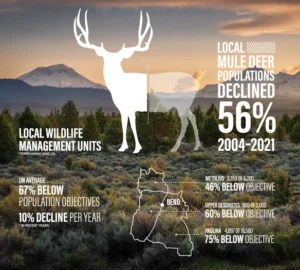The problem
Wild-ranging local mule deer populations have decreased by 56% from 2004 to 2021.
- In recent years, there has been a 10% decline in population per year
- This is 60% below objective
What is Winter Range?
Winter range is habitat deer and elk migrate to in order to find more favorable living conditions during the winter. Winter ranges are usually at lower elevations, have minimal amounts of snow cover and provide vegetation for forage, hiding, and protection from the weather. Winter Range Habitat – map
Why is Habitat Important?
Deep snows and severe winters in the high-country tax a deer’s ability to obtain necessary forage while draining fat reserves. This can result in reduced reproductive success and increased mortality. Habitat at lower elevations provides more access to food stores, albeit lower in nutrients and less digestible, with less energy expenditure.
 During the summer, deer accumulate and store body fat under their skin and around internal organs. This serves both as insulation and as energy reserves for the rigors of winter. Fat reserves can be upwards of 30 percent of total body mass. The natural winter diet (i.e. bitterbrush, sagebrush) is lower in nutrients and less digestible than the summer diet, requiring more energy to digest and resulting in fewer calories. Stored fat is burned during winter to partially compensate for the lack of nutrients in the winter diet. Deer normally lose weight during the winter.
During the summer, deer accumulate and store body fat under their skin and around internal organs. This serves both as insulation and as energy reserves for the rigors of winter. Fat reserves can be upwards of 30 percent of total body mass. The natural winter diet (i.e. bitterbrush, sagebrush) is lower in nutrients and less digestible than the summer diet, requiring more energy to digest and resulting in fewer calories. Stored fat is burned during winter to partially compensate for the lack of nutrients in the winter diet. Deer normally lose weight during the winter.
In addition, human-related disturbance can stress animals and cause them to expend unnecessary energy, which may increase winter mortality.
How do People Fit In?
Trail use in central Oregon has grown exponentially over the past few years and now includes yearlong use as opposed to just seasonal use. Disturbance may occur on rare occasions or countless times per day. This increases energy expenditures to avoid people and migrating to more marginal habitats. Ultimately, deer expend more of the energy reserves that might be needed to get them through the harshness of winter.
What Can You Do?
- Undestand that you have an impact, even though you may not see game animals.
- If you encounter a herd of deer or elk … Stop!… Put a foot down… Wait!… Let them recognize you, and let them move off on their own terms. If they run in flight, that’s bad.
- Educate your friends about the impact we have.
- Limit your activity in winter range habitat.
- Limit your group size to 4 or fewer.
- Don’t ride at dawn or dusk, prime times for foraging and feeding.
- Leave your dog at home.
Other Resources
For more information on impact, give a listen to these two podcasts:
As cyclists, we usually think that we don’t have much of an impact on our natural surroundings when we ride. “I’m on a bike; it’s not motorized; it’s fairly quiet.” Listen in on our conversation with Amy Stuart, who has worked for the Oregon Department of Fish and Wildlife for 30 years, as we learn about the impact we have as cyclists on wildlife and how we can mitigate this impact.
We continue our discussion on the impact we as cyclist have on wildlife and our surroundings. Joining us is Lauri Turner and Brock McCormick who are both Wildlife Biologists with the Deschutes National Forest.

